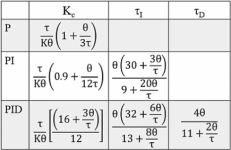N.B. there is a typo in Post #8: ".Ti and .FC" in the third paragrpaph should read ".Td and .FC." It is restated correctly in later posts, so that should not be source of @Peter's confusion. Everything else is, AFAICT, correct.
TL;DR
The rest of this post is all about returning @Peter generous trolling in kind; so feel free to ignore it as there is absolutely nothing new in it. I know, because I did the work to reverse-engineer how the CCW/Micro800 PID instruction works, and I made my best effort to ensure that everybody, but one, who bothers to read my posts to this point
should be in the same state.
Yes, but you did it with the derivative gain active too. I can see the proportional gain acts as expected because after the derivative term decays there is only the proportional term.
And you did the derivative term with the filter on. That clutters things up.
Wrong again. actually I did it before that and recorded the result in my first post cf.
post #5.
[Ti] ... I don't see it. You didn't tell us if it works as expected so how are we to know?
Wrong again, cf.
post #5.
Or maybe, if @Peter Nachtwey doesn't see something it does not exist? Do we all cease to exist every time he blinks? If a Peter blinks in a forest, ...?
NO! In post #8 you have FC labeled as the derivative gain. If it is a filter time constant ...
which it is not; wrong again: in any instance of the PID_GAINS structure/object
in the CCW/Micro800 episode of The Twilight Zone,
the .FC member expresses the quantity usually referred to as "derivative gain." I have stated that I don't know how many times; is @Peter blinking every time he skims over it?
Wrong again. "Which is it" implies I have been saying FC is more than one thing, which I have not.
FC should be set so there is no derivative filter.
Wrong again. First of all and for the umpteenth time,
.FC is not the bloody filter time constant. cf. every post of mine post #6.
Second of all, if either or both of .Td and .FC is/are 0, then there is no derivative action cf.
post #5 and
post #6 and
post #8.
The FC should be in the denominator,
Wrong again. That would be true if the FC was indeed a time constant,
but it is not.
I am not confusing the issue.
Wrong again. By continuing to treat FC as a time constant,
which it is not even though that has been stated many times, although, because you have held to your presuppositions like an I don't know what, and refused every vain plea to challenge them for so long, I suspect you are the only one confused.
What is the equation that the Micro800 uses? ... When a low pass filter is added to the derivative term it is
CV=Kc*(1+s/Ti+Td*s/(Tf*s+1))
s is the Laplace operator...
Code:
/ s FC * s \
/ 1 + -- + ------------------- \
CV = Kc * ( Ti / Td \ )
\ ( -- * s ) + 1 /
\ \ FC / /
Prove me wrong.
Caveats
Kc, Ti, Td and FC being the four members of the CCW/Micro800 PID_GAINS object structure, in that order, assuming Ti, Td and FC are positive.
N.B. I did intend, and the data support, putting FC in the numerator, as well as the denominator of the third term, as well as Td in the numerator of the denominator of the third time. I an that makes no sense semantically, but remember that derivative gains and time constants, by any other name, would smell as sweet.
N.B. This only answers the query "What is the equation that the Micro800 uses?" posed above; any relationship of those PID_GAINS members' to the canonical meanings of identical names in control theory is apparently accidental at best.







